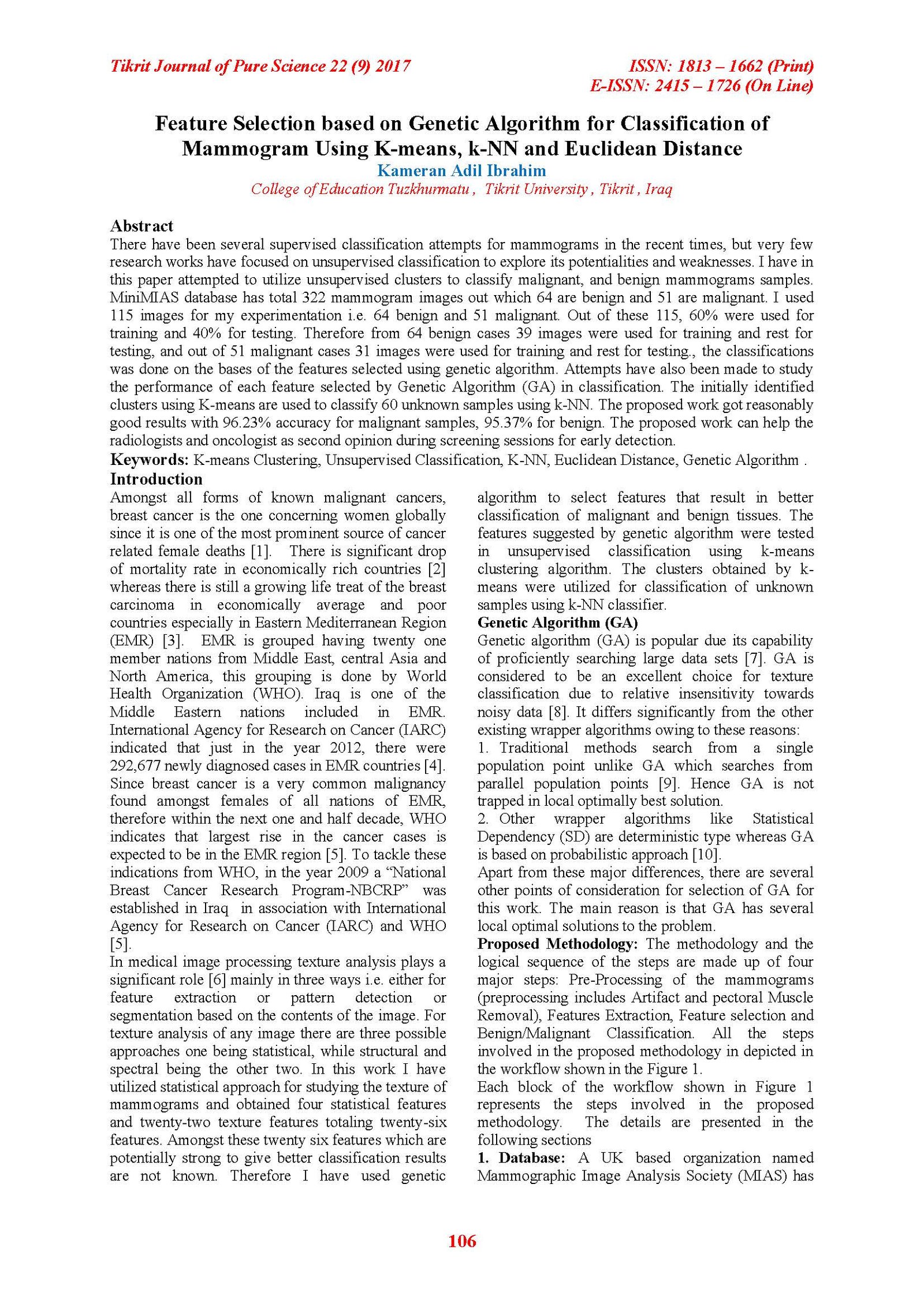Feature Selection based on Genetic Algorithm for Classification of Mammogram Using K-means, k-NN and Euclidean Distance
Main Article Content
Abstract
There have been several supervised classification attempts for mammograms in the recent times, but very few research works have focused on unsupervised classification to explore its potentialities and weaknesses. I have in this paper attempted to utilize unsupervised clusters to classify malignant, and benign mammograms samples. MiniMIAS database has total 322 mammogram images out which 64 are benign and 51 are malignant. I used 115 images for my experimentation i.e. 64 benign and 51 malignant. Out of these 115, 60% were used for training and 40% for testing. Therefore from 64 benign cases 39 images were used for training and rest for testing, and out of 51 malignant cases 31 images were used for training and rest for testing., the classifications was done on the bases of the features selected using genetic algorithm. Attempts have also been made to study the performance of each feature selected by Genetic Algorithm (GA) in classification. The initially identified clusters using K-means are used to classify 60 unknown samples using k-NN. The proposed work got reasonably good results with 96.23% accuracy for malignant samples, 95.37% for benign. The proposed work can help the radiologists and oncologist as second opinion during screening sessions for early detection.
Article Details

This work is licensed under a Creative Commons Attribution 4.0 International License.
Tikrit Journal of Pure Science is licensed under the Creative Commons Attribution 4.0 International License, which allows users to copy, create extracts, abstracts, and new works from the article, alter and revise the article, and make commercial use of the article (including reuse and/or resale of the article by commercial entities), provided the user gives appropriate credit (with a link to the formal publication through the relevant DOI), provides a link to the license, indicates if changes were made, and the licensor is not represented as endorsing the use made of the work. The authors hold the copyright for their published work on the Tikrit J. Pure Sci. website, while Tikrit J. Pure Sci. is responsible for appreciate citation of their work, which is released under CC-BY-4.0, enabling the unrestricted use, distribution, and reproduction of an article in any medium, provided that the original work is properly cited.
References
(1) Tavassoli, F. Devilee, P. Pathology And Genetics
Of Tumours Of The Breast And Female Genital
Organs; 1st ed.; IAPS Press: Lyon, 2003.
(2) Jemal, A.; Center, M.; DeSantis, C.; Ward, E.
Global Patterns Of Cancer Incidence And Mortality
Rates And Trends. Cancer Epidemiology Biomarkers
& Prevention 2010, 19, 1893-1907.
(3) Omar, S., N. H. M. Alieldin, and O. M. N. Khatib.
"Cancer magnitude, challenges and control in the
Eastern Mediterranean region." (2007).
(4) Alwan, Nada AS. "commentaries Breast Cancer
Among Iraqi Women: Preliminary Findings From a
Regional Comparative Breast Cancer Research
Project." (2016).
(5) Alwan, Nada. "Iraqi initiative of a regional
comparative breast cancer research project in the
Middle East." J Cancer Biol Res 2.1 (2014): 1016.
(6) Tuceryan, Mihran, and Anil K. Jain. "Texture
analysis." Handbook of pattern recognition and
computer vision 2 (1993): 207-248.
(7) Man, Kim-Fung, Kit-Sang Tang, and Sam
Kwong. "Genetic algorithms: concepts and
applications." IEEE transactions on Industrial
Electronics 43.5 (1996): 519-534.
(8) Osowski, Stanislaw, et al. "Application of support
vector machine and genetic algorithm for improved
blood cell recognition." IEEE Transactions on
Instrumentation and Measurement 58.7 (2009): 2159-
2168.
(9) Akhter, Nazneen, et al. "Feature Selection for
Heart Rate Variability Based Biometric Recognition
Using Genetic Algorithm." Intelligent Systems
Technologies and Applications. Springer
International Publishing, 2016. 91-101.
(10) Dy, Jennifer G. "Unsupervised feature
selection." Computational methods of feature
selection (2008): 19-39.
(11) Cohen, Alexander L., et al. "Defining functional
areas in individual human brains using resting
functional connectivity MRI." Neuroimage 41.1
(2008): 45-57.
(12) Raba, David, et al. "Breast segmentation with
pectoral muscle suppression on digital
mammograms." Iberian Conference on Pattern
Recognition and Image Analysis. Springer Berlin
Heidelberg, 2005.
(13) Zimmerman, John B., et al. "An evaluation of
the effectiveness of adaptive histogram equalization
for contrast enhancement." IEEE Transactions on
Medical Imaging 7.4 (1988): 304-312.
(14) Srinivasan, G. N., and G. Shobha. "Statistical
texture analysis." Proceedings of world academy of
science, engineering and technology. Vol. 36. 2008.
(15) Bharati, Manish H., J. Jay Liu, and John F.
MacGregor. "Image texture analysis: methods and
comparisons. "Chemometrics and intelligent
laboratory systems 72.1 (2004): 57-71.
(16) Haralick, Robert M. "Statistical and structural
approaches to texture." Proceedings of the IEEE 67.5
(1979): 786-804.
(17) Gaike, Vrushali, et al. "Application of higher
order GLCM features on mammograms." Electrical,
Computer and Communication Technologies
(ICECCT), 2015 IEEE International Conference on.
IEEE, 2015.
(18) Gaike, Vrushali, et al. "Clustering of breast
cancer tumor using third order GLCM feature."
Green Computing and Internet of Things (ICGCIoT),
2015 International Conference on. IEEE, 2015.
(19) Shaikh, Shazia, Hanumant Gite, Ramesh R.
Manza, K. V. Kale, and Nazneen Akhter.
"Segmentation of Thermal Images Using
Thresholding-Based Methods for Detection of
Malignant Tumours." In The International
Symposium on Intelligent Systems Technologies and
Applications, pp. 131-146. Springer International
Publishing, 2016.
(20) Shaikh, Shazia, Nazneen Akhter, and Ramesh R.
Manza. "Application of Image Processing Techniques
for Characterization of Skin Cancer Lesions using
Thermal Images." Indian Journal of Science and
Technology 9.15 (2016).
(21) Akhter, Nazneen, et al. "Heart-Based Biometrics
and Possible Use of Heart Rate Variability in
Biometric Recognition Systems." Advanced
Computing and Systems for Security. Springer India,
2016. 15-29.
